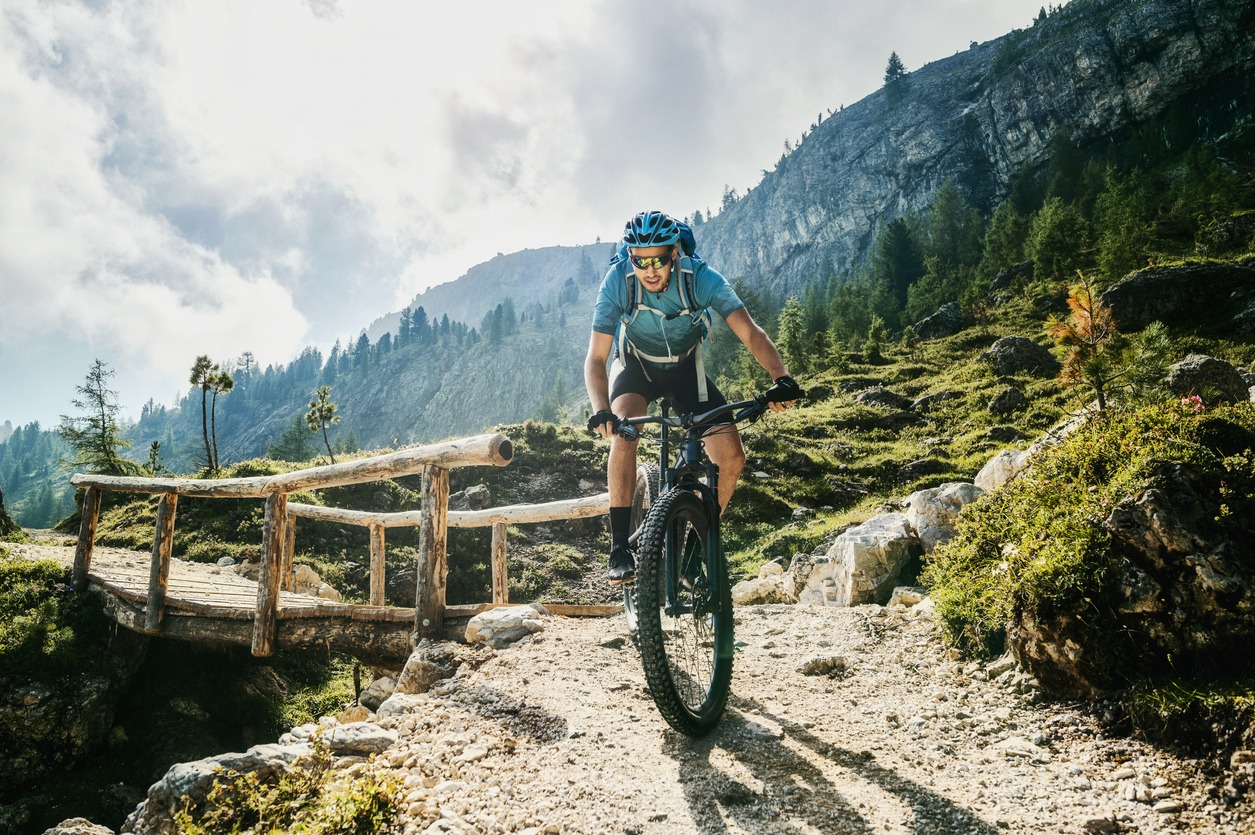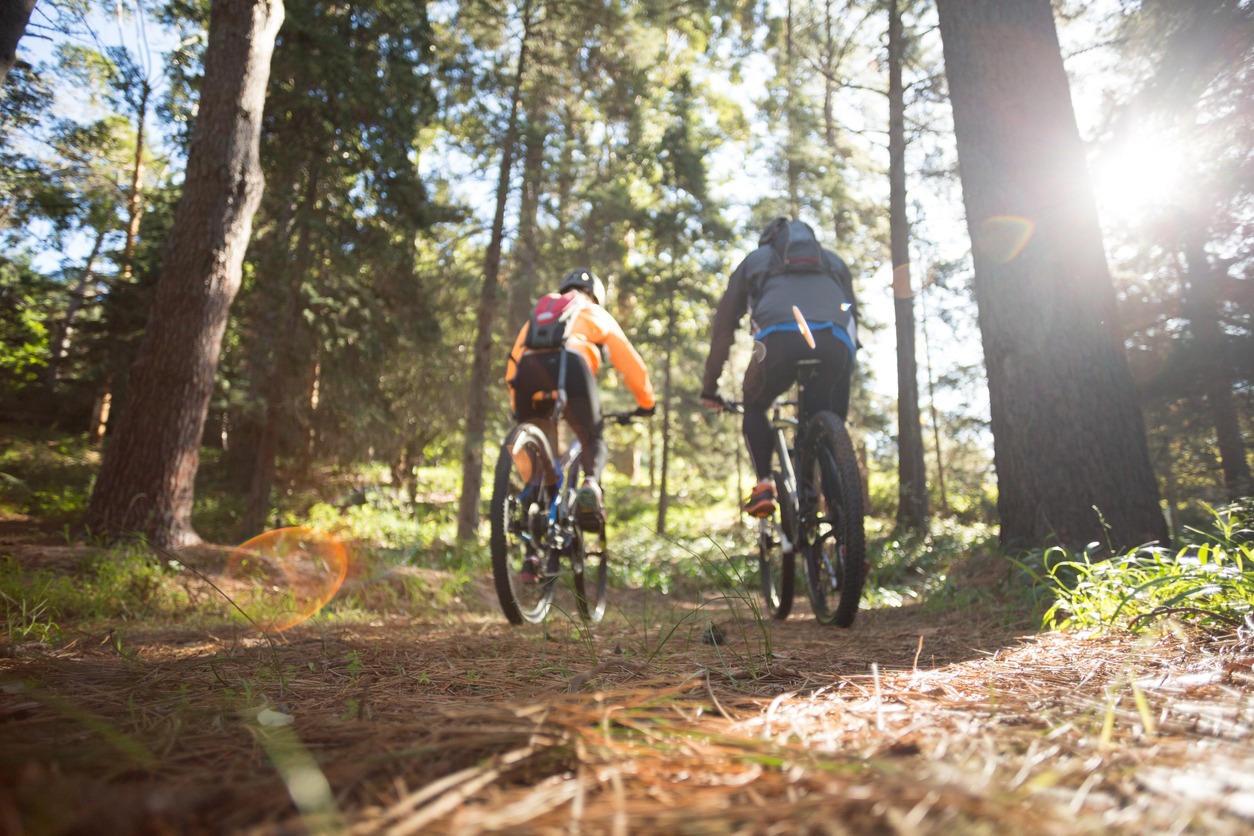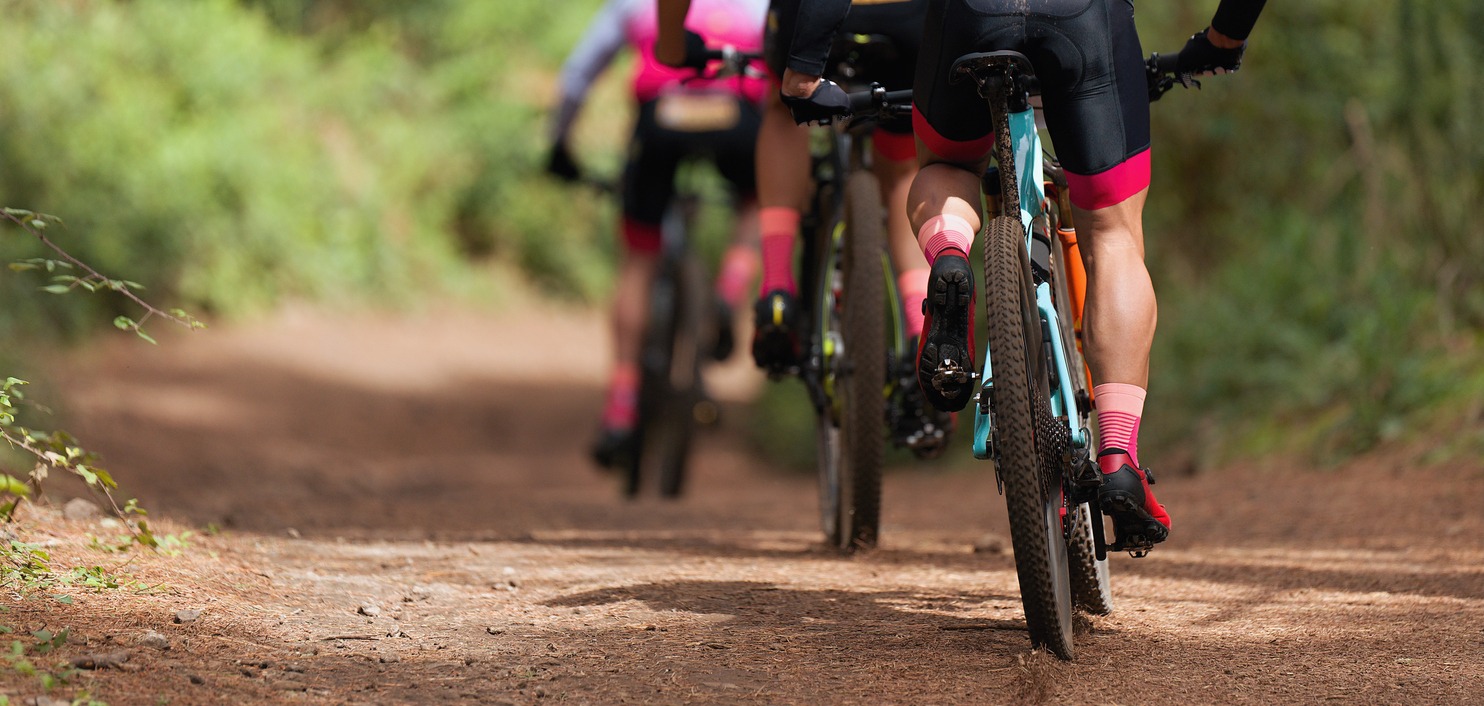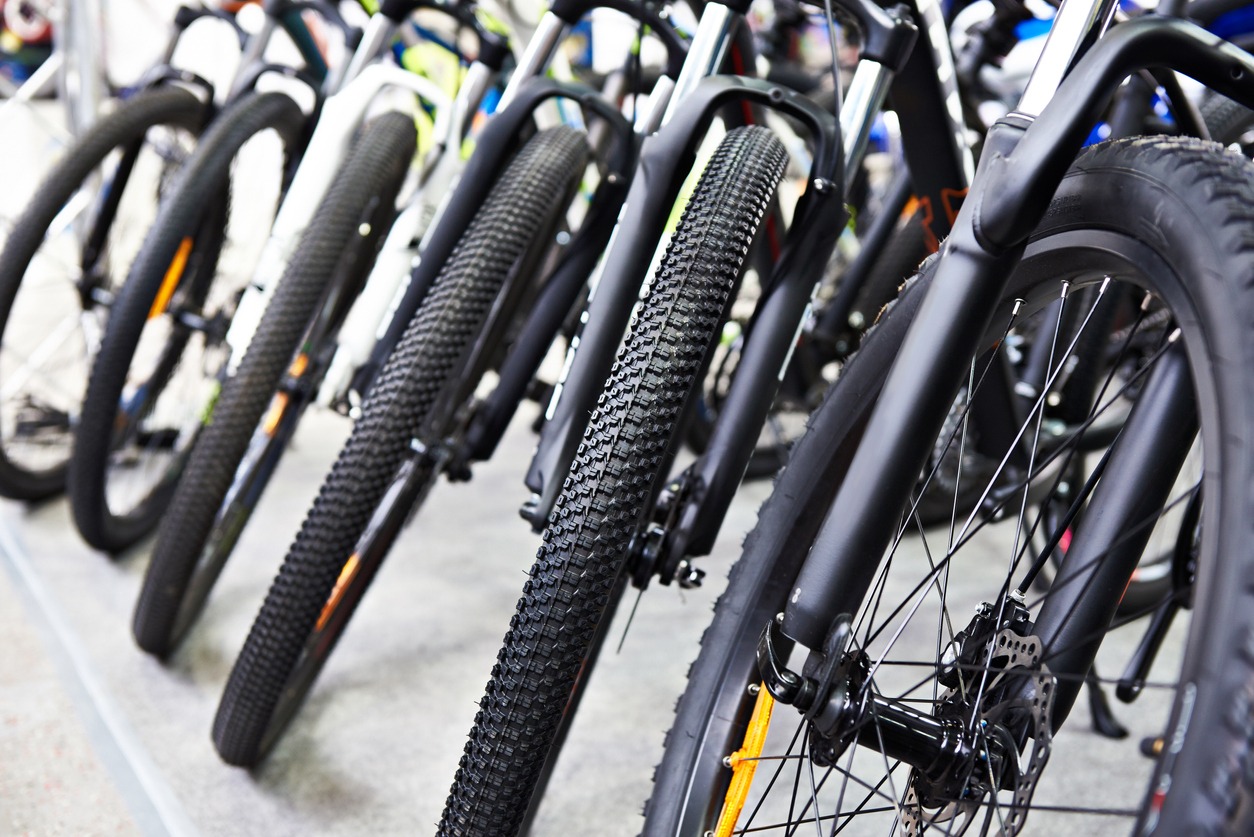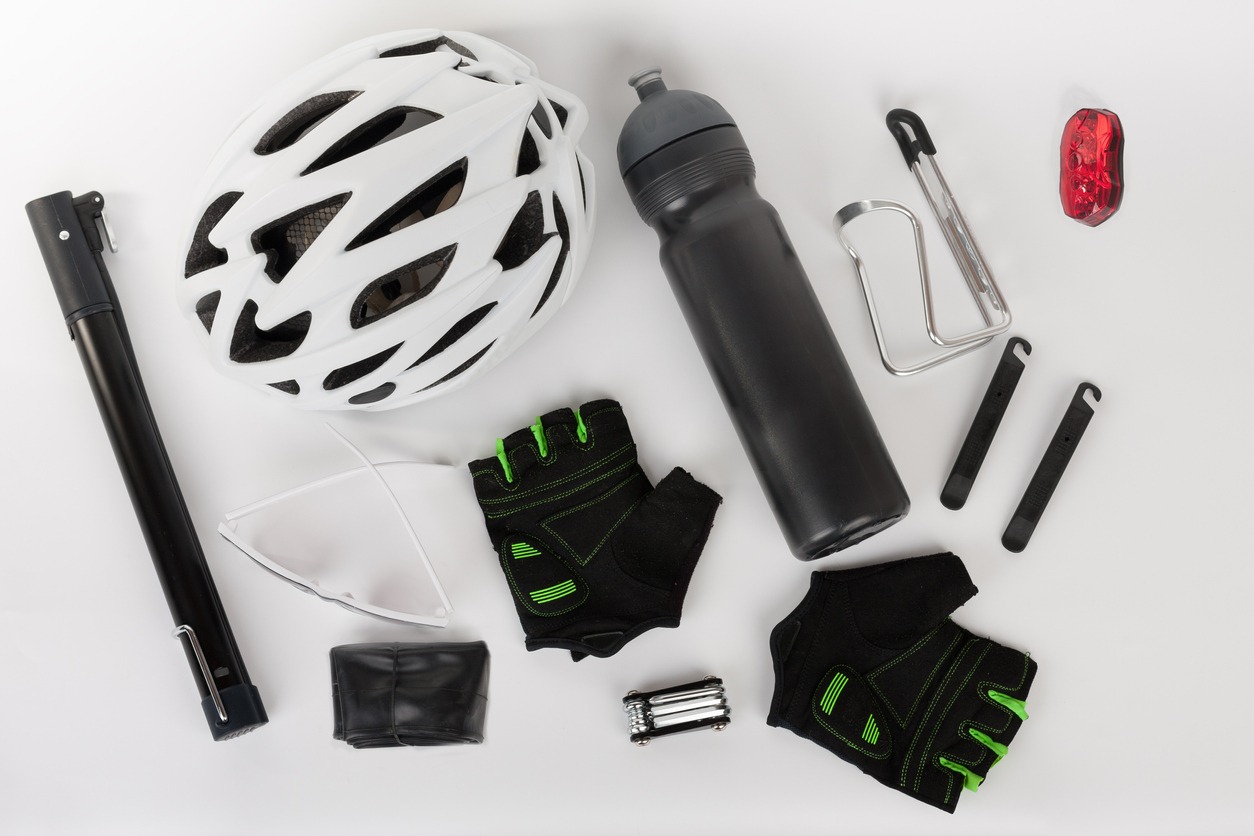Mountain biking is a fantastic way to get some exercise, have an adventure, and enjoy the great outdoors. It takes you away from city traffic and lets you explore nature on dirt paths, beautiful trails, or other bumpy terrains. And don’t be fooled by the name – you don’t need a mountain to do it! Trails can range from easy, peaceful ones in the woods to heart-pounding challenges on tricky paths and even serene desert routes.
Ready to give it a shot? In this article, we’ll give you the lowdown on mountain biking and what you need to know as a beginner.
What is Mountain Biking?
Mountain biking, also known as off-road cycling or off-roading, is all about riding a bike on various kinds of off-road trails. It takes endurance, speed, balance, and technical skills to navigate through rough terrains. Unlike road cyclists, mountain bikers seek out obstacles and see the natural world as a challenging playground filled with winding trails. Downhill slopes, steep climbs, loose rocks, streams to cross, tree roots – everything is a chance to test their skills!
Knowing how to handle a mountain bike and feeling comfy with your gear – from adjusting the saddle height and pedals to working the brakes and wearing the helmet right – is crucial for this activity. And being able to fix any bike issues that crop up along the way is a handy skill.
Mountain biking is a full-body workout. When you’re on a ride, you’re not only working your legs and giving your heart and lungs a workout but also using your upper body, especially when you’re climbing or steering. It also improves your balance, coordination, and stability. Plus, the changing scenery on every ride makes it a mentally relaxing and stress-relieving activity.
Some people see mountain biking as a sport, joining races and seeking thrilling paths worldwide. Others just enjoy it as a fun way to exercise and connect with nature.
Mountain Biking Styles
Mountain bikes come with a few key features:
- Chunky tires with tough tread for stability and durability off-road.
- A comfy, upright riding position.
- Suspension systems that soak up bumps and obstacles like rocks and roots.
Different bike makers often classify their bikes into styles of riding. This helps you pick the right bike for your adventures. But remember, just because a bike is designed for one style doesn’t mean it can’t do others, too.
Here are the different types of mountain biking:
Trail Mountain Biking
It’s perhaps the most common style. There are no racing rules here. If you want to meet pals at the local trailhead and enjoy a mix of climbs and descents, this is your jam. Trail mountain bikes are all about fun, efficiency, downhill skills, and staying light. Trail riders tackle mountain paths, fire roads, and other unpaved tracks.
Cross-Country Mountain Biking (XC)
Imagine it as hiking or mountain biking. These trails are often less technical, with gentler slopes and stunning backcountry views. They’re perfect for beginners as they don’t demand advanced skills or extreme fitness. It’s a great way to get a feel for mountain biking on singletrack trails.
It’s a less extreme form of mountain biking, as it is about completing a defined circuit or a long point-to-point trail. The terrain can vary from narrow single tracks to wider fire roads or even paved roads. There might be technical sections with natural or man-made obstacles. XC requires endurance and good bike handling skills but isn’t all about speed. Cross-country bikes are lightweight.
Downhill/Park Mountain Biking
This is the adrenaline-pumping side of mountain biking, focusing on racing down trails at high speeds. Usually, you get to the top using a car or a lift, and then it’s a thrilling descent. Ski resorts in the summer are perfect for this. Downhill bikes have full suspension, are heavier, and are built for high-speed descents.
This type of riding is often found at bike parks, especially at ski resorts during warmer months. It’s all about big, tough bikes, full-face helmets, and body armor. These bikes are built for jumps, berms, rock gardens, and ramps. While you don’t pedal much, you still get a serious workout reacting to the terrain.
All-Mountain/Enduro Mountain Biking
All-mountain/enduro mountain biking is like trail riding for those who enjoy both uphill and downhill adventures. It involves challenging climbs, thrilling descents, and various technical features—both natural and man-made. It’s like an elevated version of cross-country biking. These bikes are built to handle steep descents while still being light and agile enough for uphill pedaling.
There’s a bit of overlap between Enduro and downhill. Enduro riders can tackle downhill tracks, but the main difference is in the bikes. Downhill bikes are designed for speed and gnarly terrain, while Enduro bikes are more versatile, handling various types of riding.
The term “enduro” originally comes from racing, where riders compete in timed downhill stages and untimed uphill stages. The overall winner has the fastest combined time on the descents. Enduro riding has gained popularity, and now, the term is often used interchangeably with all-mountain, whether you’re racing or not.
Fat-Tire Biking
Imagine the kind of bike you dreamed of as a kid: one with massive tires that can roll over just about anything. Fat-tire bikes have tires that are at least 3.7 inches wide (some are even wider). They offer exceptional traction on surfaces like snow and sand, but they’re not limited to those conditions. Some people ride fat-tire bikes on regular trails, too. These bikes are forgiving on rough terrain, making them an excellent choice for beginner mountain bikers.
Choosing Your First Mountain Bike
So, you’ve decided to give mountain biking a try, but the bike options seem overwhelming, right? Don’t worry; as a beginner, it doesn’t have to be complicated. When you’re just starting, any bike can be a good bike.
Starting with mountain biking doesn’t mean you need to break the bank. You can rent or test-ride mountain bikes before making a big purchase. Many bike shops offer demo bikes for a fee, and sometimes, you can apply that fee toward your purchase. Look for local mountain bike events or festivals where brands may let you try out their bikes.
Your choice of bike often depends on where you plan to ride. Suspension type and wheel size are critical factors that determine a bike’s terrain capabilities. There’s a wide range of options for suspension and wheel size. We’ll give you a basic overview, but for a comprehensive guide on choosing a mountain bike, be sure to read our in-depth guide.
To keep things simple, focus on these four key factors when you’re in the market for your first mountain bike:
1. Suspension type
Suspension plays a crucial role in keeping your bike’s wheels on the ground, ensuring control as you ride. Here’s a breakdown of your options:
Rigid Mountain Bikes
These bikes have no suspension at all. They’re easy to maintain and cost-effective, but most riders prefer suspension for added comfort. Exceptionally, most fat-tire bikes are rigid, relying on their wide tires and low pressure to absorb trail bumps.
Hardtail Mountain Bikes
Hardtails have a front fork suspension to absorb impact at the front wheel, but the rear remains without suspension, hence “hardtail.” They are generally more affordable and require less maintenance. Hardtails are suitable for most types of riding except for serious downhill trails.
Hardtail mountain bikes are excellent for cross-country riding, prioritizing speed and efficiency. They’re lighter and more efficient, but they may not handle rocky terrain as smoothly.
Full-Suspension Mountain Bikes
These bikes have both front fork and rear shock suspension systems to absorb trail impacts, providing a smoother, more forgiving ride. Full-suspension bikes can handle rough terrain, but they may lose some energy during uphill climbs. Many full-suspension bikes allow you to lock out the rear suspension for better power transfer on climbs.
Full-suspension mountain bikes come in various configurations, with travel ranging from 100mm for cross-country to 200+ mm for downhill bikes. Short-travel bikes are ideal for cross-country, while mid-travel bikes suit all-mountain or enduro riding.
Mixed Wheel Bikes (Mullets)
These bikes are gaining popularity, featuring a 29″ front wheel and a 27.5″ rear wheel. This combination provides the advantages of speed and stability at the front while maintaining nimble agility at the rear. Some bikes are designed as mullets, while others can be converted into this configuration.
2. Frame size
Next up is frame size – it’s crucial to get this right for a comfy ride. Your height usually determines your frame size, and it’s pretty standard across the board. An ill-fitting bike can really affect your mountain biking fun, so avoid going too big or too small.
Each bike brand has its own sizing charts and recommendations to help you find the perfect fit.
3. Wheel size
Now, let’s talk about wheel size. Mountain bikes come with two main wheel sizes: 27.5″ and 29″. There’s no one-size-fits-all answer here; it boils down to personal preference.
26 in. Wheels – Not too long ago, all mountain bikes came with 26-inch wheels. While they offer great responsiveness and maneuverability, nowadays, it’s more common to hear the question, “26, 27.5, or 29 inches?” when shopping for mountain bikes. Finding new adult-sized bikes with 26-inch wheels is rare because 27.5 and 29-inch wheels are more efficient and better at handling trail obstacles. If you opt for a used 26-inch wheel bike, expect it to be somewhat dated and possibly in need of significant maintenance.
27.5 in. (650b) – These wheels strike a middle ground between the agility of 26-inch wheels and the terrain-conquering ability of 29ers. They roll over terrain more easily than 26-inch wheels but maintain good maneuverability. While they often suit riders on smaller frames, it ultimately comes down to personal preference. Many riders prefer 27.5-inch wheels for their responsiveness and playfulness, making them a solid choice for those learning jumps or spending time on bike park features.
29ers – These bikes feature 29-inch wheels, which are typically heavier and slower to accelerate but excel at covering rough terrain once in motion. They offer excellent grip and easily roll over trail obstacles, making them a favorite among cross-country riders. They are available in both hardtail and full-suspension configurations.
29-inch wheels tend to be faster and more stable at high speeds compared to 27.5-inch wheels. They climb effectively and handle rocks and roots with ease. However, their larger size can make them less nimble and agile, especially when navigating tight corners.
4. Frame material
The last thing to think about when buying a mountain bike is what material you want for the frame: Carbon or Aluminum.
Carbon is a popular choice among experienced riders due to its lightweight and robust nature. However, it’s notably more expensive, around 1.5-2 times the cost of aluminum. If you’re new to mountain biking and this is your first bike, my suggestion is to lean towards an aluminum frame.
Think of this first bike as your training wheels—it’s going to take some knocks and scrapes as you learn. Investing thousands more in a beautiful carbon bike might not be the best idea if it’s going to endure this kind of wear and tear.
That said, if you plan to stick to mellow cross-country trails and have the budget for a carbon bike, go ahead! But if you’re looking to explore bike parks and sharpen your skills, an aluminum frame is a wise first choice. It can handle the fun and games while you learn the ropes.
What to Wear When Mountain Biking
Wearing the right gear can make your mountain biking experience much more enjoyable. The type of mountain biking you’re into will determine what clothing and protective gear to go for.
1. Mountain bike shorts
You’ll find two main styles here. Cross-country riders often go for snug Lycra shorts with padded chamois to reduce saddle fatigue. Trail riders, on the other hand, prefer baggy shorts over padded ones for a more casual look and extra abrasion protection in case of spills. Many baggy shorts also come with an inner liner short featuring a chamois.
2. Mountain bike jerseys and shirts
Just like shorts, jerseys come in different styles, from form-fitting zip-ups with pockets to loose T-shirt styles. Regardless of fit, prioritize moisture-wicking and quick-drying fabrics. Look for something easy to clean, especially if you plan to wear a backpack, as you won’t need lots of pockets.
3. Mountain bike gloves
Most mountain bikers wear gloves for better grip on sweaty handlebars and to prevent blisters. Full-fingered gloves also keep your hands warm and provide added protection in case of a fall. Some gloves even feature extra padding on the palms, hands, and fingers for added safety.
4. Mountain bike helmets
These helmets offer more coverage and protection compared to road bike helmets. Look for helmets with proper ventilation and rear-head coverage. For downhill riding, consider a full-face helmet, often available for rent at bike parks.
Remember, safety is paramount, so never ride without a helmet. Different styles of cycling may require different helmet features, so choose one that suits your riding style. Some helmets now incorporate Mips technology, an extra layer that reduces rotational forces on the brain during angled impacts.
5. Mountain bike shoes and pedals
The perfect shoe and pedal combo depends on your comfort level and the type of riding you’re planning to tackle. No matter your riding style, go for shoes with sturdy toe protection, good grip for hiking, and water resistance for wet conditions.
Flat mountain bike pedals: If you’re new to mountain biking or not yet confident with it, start with flat platform pedals (the kind without a cleat system). They allow you to quickly get on and off the bike and put your foot down without unclipping from the pedal. This is a great way to build your skills and transition smoothly to clipless pedals when you’re ready.
Clipless mountain bike pedals: As your skills advance, you can choose between clipless pedals with compatible shoes or sticking with platform pedals. Clipless pedals (ironically, they attach to your shoes using a cleat system) provide better control and power transfer. However, they require more commitment, especially in challenging terrain. If you’re new to clipless pedals, practice on soft grassy ground to get the hang of connecting and disconnecting your foot.
Remember, no matter your style, look for shoes with durable toe protection, a solid grip for hiking, and water resistance to handle rain and mud. For more detailed info, check out our guides on how to choose and use bike pedals and bike shoes.
6. Hydration packs
Hydration packs are essential for mountain biking, offering the convenience you need. Opt for a pack that provides ample storage space for extra clothing, repair tools, and snacks and features a clip to secure your hydration sleeve to the shoulder or sternum strap.
7. Mountain bike repair kit essentials
Save yourself from a lot of hassle and walking by packing essential tools for in-the-field repairs: carry a spare tube, a hand pump or CO2 inflator, and a compact multitool with various Allen wrenches and a chain tool. These tools can make the difference between continuing your ride or calling it a day.
Types of Mountain Biking Trails
In the world of mountain biking, you’ll encounter different types of trails and various difficulty ratings, especially in areas with extensive trail systems. It’s crucial to understand the type of riding you’ll encounter before hitting the trails. Check out trail maps for your area to get familiar with what’s available, and look for signs at trailheads and junctions indicating difficulty levels. Understanding both trail types and rating systems will help you choose rides that suit your preferences.
Explore the mountain biking trails in your local area. Some areas offer excellent cross-country riding with plenty of miles and moderate elevation changes. In contrast, mountainous regions may provide trail systems with more technical and steeper terrain. Knowing what’s available will help you select the right bike and plan exciting routes.
Singletrack
Singletrack is the most common type of mountain bike trail, typically as wide as your shoulders. Riders generally navigate it in a single file, with enough space for two bikes to pass. Many singletrack trails are one-way and wind their way through the best terrain the landscape offers. Singletrack is highly sought-after for cross-country and trail riders, providing an excellent balance between flow and technical challenge. While some singletrack trails allow for two-way traffic, with downhill riders yielding to uphill riders, others are strictly one-way.
Doubletrack
Doubletrack trails are usually double the width or more of singletrack, allowing two bikes to ride side by side. Often following abandoned logging roads, fire roads, or power-line roads, these trails tend to have fewer technical features than singletrack. Doubletrack trails accommodate riders going in both directions, making it easier to yield to others on the trail. However, they may not flow as well or offer as much technical challenge as singletrack.
Bike Parks
Mountain bike skills parks are cropping up in various places, from urban jump-and-pump tracks to lift-serviced trails at ski resorts. These parks are often conveniently located near metropolitan areas and provide excellent opportunities for beginners and experienced riders to enhance their skills. Expect features like elevated bridges, halfpipes, jumps of varying sizes, berms, banked corners, and downhill switchbacks. Bike parks are specifically designed for downhill riders seeking jumps and terrain features, making them ideal for experienced riders. If you’re just starting, consider them once you’ve gained some technical experience on trails.
